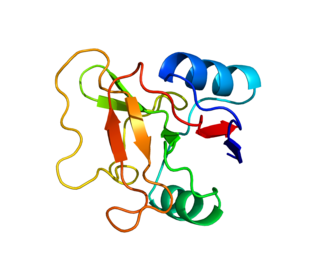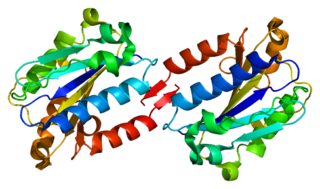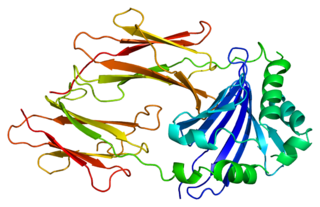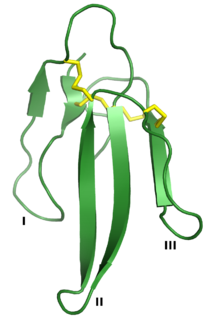Related Research Articles

Urokinase, also known as urokinase-type plasminogen activator (uPA), is a serine protease present in humans and other animals. The human urokinase protein was discovered, but not named, by McFarlane and Pilling in 1947. Urokinase was originally isolated from human urine, and it is also present in the blood and in the extracellular matrix of many tissues. The primary physiological substrate of this enzyme is plasminogen, which is an inactive form (zymogen) of the serine protease plasmin. Activation of plasmin triggers a proteolytic cascade that, depending on the physiological environment, participates in thrombolysis or extracellular matrix degradation. This cascade had been involved in vascular diseases and cancer progression.

The Urokinase receptor, also known as urokinase plasminogen activator surface receptor (uPAR) or CD87, is a protein encoded in humans by the PLAUR gene. It is a multidomain glycoprotein tethered to the cell membrane with a glycosylphosphotidylinositol (GPI) anchor. uPAR was originally identified as a saturable binding site for urokinase on the cell surface.

ICAM-1 also known as CD54 is a protein that in humans is encoded by the ICAM1 gene. This gene encodes a cell surface glycoprotein which is typically expressed on endothelial cells and cells of the immune system. It binds to integrins of type CD11a / CD18, or CD11b / CD18 and is also exploited by rhinovirus as a receptor for entry into respiratory epithelium.

L-selectin, also known as CD62L, is a cell adhesion molecule found on leukocytes and the preimplantation embryo. It belongs to the selectin family of proteins, which recognize sialylated carbohydrate groups. It is cleaved by ADAM17.

Integrin, alpha L , also known as ITGAL, is a protein that in human is encoded by ITGAL gene. CD11a functions in the immune system. It is involved in cellular adhesion and costimulatory signaling. It is the target of the drug efalizumab.

Protein tyrosine phosphatase, receptor type, C also known as PTPRC is an enzyme that, in humans, is encoded by the PTPRC gene. PTPRC is also known as CD45 antigen, which was originally called leukocyte common antigen (LCA).

Thy-1 or CD90 is a 25–37 kDa heavily N-glycosylated, glycophosphatidylinositol (GPI) anchored conserved cell surface protein with a single V-like immunoglobulin domain, originally discovered as a thymocyte antigen. Thy-1 can be used as a marker for a variety of stem cells and for the axonal processes of mature neurons. Structural study of Thy-1 led to the foundation of the Immunoglobulin superfamily, of which it is the smallest member, and led to some of the initial biochemical description and characterization of a vertebrate GPI anchor and also the first demonstration of tissue specific differential glycosylation.

CD69 is a human transmembrane C-Type lectin protein encoded by the CD69 gene. It is an early activation marker that is expressed in hematopoietic stem cells, T cells, and many other cell types in the immune system. It is also implicated in T cell differentiation as well as lymphocyte retention in lymphoid organs.

HLA class I histocompatibility antigen, alpha chain F is a protein that in humans is encoded by the HLA-F gene.

HLA class II histocompatibility antigen, DM beta chain is a protein that in humans is encoded by the HLA-DMB gene.

CD48 antigen also known as B-lymphocyte activation marker (BLAST-1) or signaling lymphocytic activation molecule 2 (SLAMF2) is a protein that in humans is encoded by the CD48 gene.

Lymphocyte-specific protein 1 is a protein that in humans is encoded by the LSP1 gene.

CD84 is a human protein encoded by the CD84 gene.

Cluster of Differentiation 276 (CD276) or B7 Homolog 3 (B7-H3) is a human protein encoded by the CD276 gene.

Secreted Ly-6/uPAR-related protein 1 is a protein that in humans is encoded by the SLURP1 gene. It exerts anti-inflammatory effects, acts as a tumor suppressor, and antagonizes nicotinic receptors.

The LU domain is an evolutionarily conserved protein domain of the three-finger protein superfamily. This domain is found in the extracellular domains of cell-surface receptors and in either GPI-anchored or secreted globular proteins, for example the Ly-6 family, CD59, and Sgp-2.
Lymphocyte antigen 6 complex, locus G6E (pseudogene) is a protein that in humans is encoded by the LY6G6E gene.
Cancer/testis (CT) antigens are a group of proteins united by their importance in development and in cancer immunotherapy. In general, expression of these proteins is restricted to male germ cells in the adult animal. However, in cancer these developmental antigens are often re-expressed and can serve as a locus of immune activation. Thus, they are often classified as tumor antigens. The expression of CT antigens in various malignancies is heterogeneous and often correlates with tumor progression. CT antigens have been described in melanoma, liver cancer, lung cancer, bladder cancer, and pediatric tumors such as neuroblastoma. Gametogenesis offers an important role for many of these antigens in the differentiation, migration, and cell division of primordial germ cells, spermatagonia spermatocytes and spermatids. Because of their tumor-restricted expression and strong in vivo immunogenicity, CT antigens are identified as ideal targets for tumor specific immunotherapeutic approaches and prompted the development of several clinical trials of CT antigens-based vaccine therapy. CT antigens have been found to have at least 70 families so far, including about 140 members, most of which are expressed during spermatogenesis. Their expression are mainly regulated by epigenetic events, specifically, DNA methylation.

Three-finger proteins or three-finger protein domains are a protein superfamily consisting of small, roughly 60-80 amino acid residue protein domains with a common tertiary structure: three beta strand loops extended from a hydrophobic core stabilized by disulfide bonds. The family is named for the outstretched "fingers" of the three loops. Members of the family have no enzymatic activity, but are capable of forming protein-protein interactions with high specificity and affinity. The founding members of the family, also the best characterized by structure, are the three-finger toxins found in snake venom, which have a variety of pharmacological effects, most typically by disruption of cholinergic signaling. The family is also represented in non-toxic proteins, which have a wide taxonomic distribution; 3FP domains occur in the extracellular domains of some cell-surface receptors as well as in GPI-anchored and secreted globular proteins, usually involved in signaling.

LY6/PLAUR Domain Containing 6B, also known under the name Cancer/Testis Antigen 116 (CTA116) and LYPD7 is encoded by the LYPD6B gene. LYPD6B is a member of the lymphocyte antigen 6 (LY6) protein family. It is expressed in the testis, lungs, stomach and the prostate and in the nervous system where it acts as a modulator of nicotinic acetylcholine receptor activity.
References
- 1 2 3 4 5 6 7 8 9 10 Loughner CL, Bruford EA, McAndrews MS, Delp EE, Swamynathan S, Swamynathan SK (April 2016). "Organization, evolution and functions of the human and mouse Ly6/uPAR family genes". Human Genomics. 10 (1): 10. doi:10.1186/s40246-016-0074-2. PMC 4839075 . PMID 27098205.
- ↑ Lee PY, Wang JX, Parisini E, Dascher CC, Nigrovic PA (October 2013). "Ly6 family proteins in neutrophil biology". Journal of Leukocyte Biology. 94 (4): 585–94. doi:10.1189/jlb.0113014. PMID 23543767. S2CID 1252351.
- 1 2 3 4 5 Kong HK, Park JH (November 2012). "Characterization and function of human Ly-6/uPAR molecules". BMB Reports. 45 (11): 595–603. doi:10.5483/bmbrep.2012.45.11.210. PMC 4133805 . PMID 23186997.
- 1 2 3 4 5 Upadhyay G (2019). "Emerging Role of Lymphocyte Antigen-6 Family of Genes in Cancer and Immune Cells". Frontiers in Immunology. 10: 819. doi: 10.3389/fimmu.2019.00819 . PMC 6491625 . PMID 31068932.
- ↑ Sidenius N, Blasi F (June 2003). "The urokinase plasminogen activator system in cancer: recent advances and implication for prognosis and therapy". Cancer and Metastasis Reviews. 22 (2–3): 205–22. doi:10.1023/A:1023099415940. PMID 12784997. S2CID 5765336.
- 1 2 McKenzie IF, Gardiner J, Cherry M, Snell GD (March 1977). "Lymphocyte antigens: Ly-4, Ly-6, and Ly-7". Transplantation Proceedings. 9 (1): 667–9. PMID 68598.